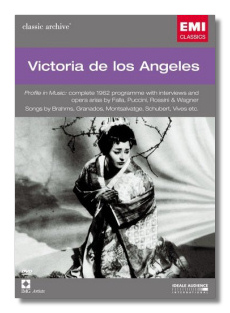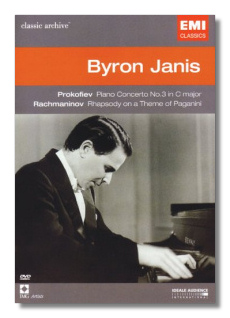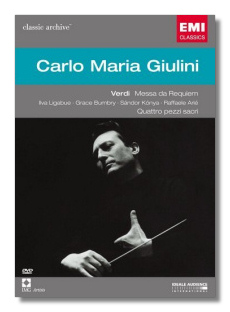
The Internet's Premier Classical Music Source
Related Links
- Latest Reviews
- More Reviews
-
By Composer
-
Collections
DVD & Blu-ray
Books
Concert Reviews
Articles/Interviews
Software
Audio
Search Amazon
Recommended Links
Site News
 DVD Review
DVD Review
EMI Classic Archive

A Profile in Music
- Johannes Brahms: Song "Vergebliches Ständchen", Op. 84 #4
- Manuel de Falla: La vida breve: Vivan los que rien!
- Enrique Granados: Colección de tonadillas #6, El majo timido
- Federico Mompou: Damunt de tu, només les flors
- Xavier Montsalvatge: Cancione negras #4, Canción de cuna para dormir a un negrito
- Joaquín Nin: Canto populares españoles #15, Paño murciano
- Giacomo Puccini: Madama Butterfly - Con onor muore
- Gioachino Rossini: Il barbiere di Siviglia - Una voce poco fa…Io sono dolcile
- Franz Schubert: Die schöne Müllerin, D 795/Op. 25 #2, Wohin?
- Amadeo Vives: Canciones epigramáticas - El retrato de Isabela & El amor y los ojos
- Richard Wagner: Tannhäuser - Dich, teure Halle
Victoria de los Angeles, soprano
Gerald Moore, Patrick Harvey, Felix Zanetti, Federico Mompou, piano
Royal Philharmonic Orchestra/Georges Prêtre
EMI Classics DVB310203-9 DVD mono 66:45


- Serge Prokofieff: Piano Concerto #3 in C Major, Op. 26 1
- Sergei Rachmaninoff: Rhapsody on a Theme of Paganini, Op. 43 2
- Johannes Brahms: 3
- Hungarian Dances #4 and #5
- Piano Sonata #2 in F Sharp minor, Op. 2
Byron Janis, piano
1 Orchestre National de la RTF/Paul Paray
2 Orchestre Philharmonique de l'ORTF/Louis de Froment
3 Julius Katchen, piano
EMI Classics DVB310199-9 DVD mono 78:05


Giuseppe Verdi
- Messa di Requiem
- Quattro pezzi sacri
Ilva Ligabue, soprano
Grace Bumbry, mezzo-soprano
Sándor Kónya, tenor
Raffaele Arié
Philharmonia Orchestra & Chorus/Carlo Maria Giulini
New Philharmonia Orchestra & Chorus/Carlo Maria Giulini
EMI Classics DVB310205-9 DVD mono 129:47
EMI Classics, in collaboration with the BBC, IMG Artists, and Idéale Audience International, again has released a tantalizing group of DVDs in their "Classic Archive" series. These discs "offer a unique historical glimpse into our classical heritage," and are "lovingly restored, using the finest state-of-the-art technology."
Fans of the great Spanish soprano Victoria de los Angeles need not hesitate over the DVD devoted to her: it is a treasure. The first segment, filmed in a television studio, features the soprano singing songs by Schubert (Wohin? and An die Musik), Brahms (Vergebliches Ständchen), Falla (Jota), and Vives (the mischievous El retrato de Isabela) with Gerald Moore at the piano. The year was 1957, the soprano's voice was at its freshest, and her personality at its most charming. Perhaps the Schubert and Brahms songs are a surprise for some, but de los Angeles had a huge repertoire, and her German is hardly less idiomatic than her French. The third segment was filmed at the 1967 Festival de Besançon, this time with Felix Zanetti accompanying de los Angeles. This is a tease, because here she sings only three tiny songs by Granados (El majo timido, De aquel majo amante, and El tralalá y el punteado), two equally tiny ones by Vives (El amor y los ojos and El retrato de Isabela again), and Montsalvatge's gorgeous lullaby, Canción de cuna para dormir a un negrito. Like her figure, the soprano's voice had started to spread a little by 1967, but this still is heavenly singing, and her stage manner is warm, simple, and very communicative. To hear de los Angeles sing them is to fall in love with these songs… and also with her.
Most interesting is the "Profile in Music" filmed by the BBC in 1962. In a studio setting with minimal sets, de los Angeles sings "Vivan los que ríen" from La vida breve, "Una voce poco fa" from Barbiere, a song by Nin, Elisabeth's greeting from Tannhäuser, and Madama Butterfly's death scene. In between selections she is interviewed by John Freeman. Unfortunately, the interviewer comes off as something of a boor as he genteelly digs for dirt about de los Angeles's opinions concerning other singers and other nationalities. She doesn't go for the bait, however; this woman had class both on stage and off. Freeman seems disappointed when she tells him that she enjoys working with German artists most. At one point he even calls her "Miss Los Angeles"! The singing in this segment is searingly beautiful and dramatic, and even the scene from Butterfly makes the desired emotional impact, even though we are denied the pleasure of seeing her in the rest of the opera! In the operatic selections, she is accompanied by Prêtre and the Royal Philharmonic, although they are nowhere to be seen. (I expect that they were pre-recorded; there's no indication that de los Angeles's singing is not "live" here, however.)
The "bonus" on this DVD is a film of de los Angeles singing Mompou's exquisite song Damunt de tu nomées les flors with the composer accompanying her. This was filmed in 1971 – apparently at the composer's home - and is the only color segment on this DVD. All of the songs and arias are subtitled. The quality of the sound is very acceptable throughout, although it gets better as the source material gets more recent. The "Profile in Music" and Mompou segments are the best visually, although the other two are not at all difficult to watch – just a little faded and diffuse. These performances cut right through the intervening decades.
Pennsylvania-born pianist Byron Janis probably is most famous for several recordings that he made for Mercury Records early in the stereo era. In fact, one of his most famous records is of Prokofieff's Piano Concerto #3, which he recorded with Kiril Kondrashin and the Moscow Symphony Orchestra in 1962 (Mercury 434333-2). The version presented on this DVD was filmed at the ORTF in Paris a little more than a year later, on December 28, 1963. Paul Paray is a more poetic, cantabile conductor than Kondrashin, who emphasizes the concerto's brashness, but Janis remains a master of the score's motoric rhythms and unexpectedly melancholic moments. The orchestra is oddly arranged on the stage, probably to allow the cameras unrestricted access to Janis. The Rhapsody on a Theme by Paganini was filmed in 1968, this time with conductor Louis de Froment. The conductor takes a very unsentimental view of the score, even in the beloved 18th variation. Janis seems a little less fluid and comfortable here than he did in the Prokofieff. I suspect that de Froment's straitlaced conducting has something to do with that. The camera-work in both the Prokofieff and Rachmaninoff is odd;
sometimes the camera is far from where one would expect it to be. (For example, at Janis's entrance in the Rachmaninoff, it is not on him but on some of the violins.) In both films, however, we are given ample opportunity to watch both Janis's hands and his face, which often seems contorted with the intensity of his music-making.
If anything, the bonus material is even more impressive. Julius Katchen is another American pianist, and one who became closely associated with the music of Johannes Brahms. To hear and see him playing two Hungarian Dances and the Piano Sonata #2 is a rare treat. His technique is rock-solid, and his sympathy with the music in total. As the sonata progresses he becomes so drenched in sweat that it begins to roll down his face – a testimony not just to the heat of the lights in the ORTF studio but to Katchen's involvement. When the camera pays attention to his face in the second movement of the sonata, we see him with his eyes closed and in a sort of ecstasy. Hearing him play this music, our ecstasy is not far behind his.
The material is all in black-and-white, and the quality of the images is tolerable. The monaural sound is equally tolerable. The unflattering balance between the pianist and the orchestra in the Rachmaninoff makes Janis's playing sound harder than it probably was.
Carlo Maria Giulini made one of the most acclaimed studio recordings of Verdi's Requiem in 1964. For those sessions, his soloists were Schwarzkopf, Ludwig, Gedda, and Ghiaurov. The concert from Royal Festival Hall preserved here also dates from 1964, but his quartet of soloists is completely different – to good effect, I think. The gentle, even vulnerable singing of Ligabue – an underrated singer – and Kónya is balanced by the more highly charged and overtly exciting contributions of Bumbry and Arié. The bass cuts a fascinating figure. He looks casual, perhaps a little sloppy, even scratching himself at one point during Kónya's "Ingemisco," and when he stands to sing, the score usually is folded and held close to him. This casualness belies an imposing intensity of expression, however. One imagines that he was a formidable actor in opera. This a fine quartet of soloists, and the Philharmonia Chorus sings crisply and eloquently at all dynamic levels. (It really IS true that it is easier for a large chorus to sing softly than for a smaller one.)
I am of two minds about Giulini's conducting, especially in the Requiem. It is hard-driven and unrelenting, much as Toscanini's was in this work. After a while, it becomes wearing; if it burns at white heat all the time, hellfire ceases to be as painful. Did Verdi really intend to put listeners in a state of panic about their souls with this work? The "Sanctus" is so fast it sounds like a whirling finale by Rossini. During the "Dies irae," when the cameras cut to the conductor, we see him flailing around and bug-eyed, like a man being electrocuted. Well, it's all very exciting, and I don't doubt Giulini's sincerity, to say nothing of his involvement with the music. It's just that I like him better later in his career, when his conducting became less physical and more cerebral.
Again, the quality of the sound and of the black-and-white picture does not meet modern standards, but it certainly will not get in the way of anyone's enjoyment. The Quattro pezzi sacri, filmed in 1968 in the Fairfield Hall in Croydon, look and sound clearer, but only marginally.
Earlier "Classic Archive" releases included a booklet filled with interesting notes about the performers. This time around, while the booklets remain, the booklet notes are gone, leaving only a list of track timings. Not to worry, though: if you are so inclined, you can put the DVD into your computer and read the "booklets" that way. As for myself, I spend enough time on the computer as it is, so I will be enjoying these DVDs in my DVD player, and not on my computer!
Copyright © 2006, Raymond Tuttle




















